Polly Toynbee of the Guardian has leveled one of the most serious (and irresponsible) charges against the Catholic Church: that She’s to blame for millions of dead Africans. In a 2005 article for the Guardian, she wrote:
How dare Tony Blair genuflect on our behalf before the corpse of a man whose edicts killed millions? […] With its ban on condoms the church has caused the death of millions of Catholics and others in areas dominated by Catholic missionaries, in Africa and right across the world. In countries where 50% are infected, millions of very young Aids orphans are today’s immediate victims of the curia.
This is a common meme. Arch-atheist Richard Dawkins used this same argument to argue that the Catholic Church was in the running for the major institution that “most deserves the title of greatest force for evil in the world.” So let’s tackle this argument head-on: Is the Catholic stance against contraception responsible for the AIDS-related deaths of millions of Africans?
Well, why not see what the data says? After all, these are the same atheists who routinely crow about being interested in real knowledge and reason, rather than faith. So let’s put their faith to the test. If the Catholic Church’s teachings against condoms are causing millions of Africans to contract AIDS, we should expect to see heavily-Catholic countries with far higher AIDS rates than their non-Catholic counterparts. So I decided to compare the rates by region and by country.
Fortunately for me, the contributors at Wikipedia already extracted and organized almost all of the data I needed. Using the CIA World Factbook data on religion and AIDS, they’ve organized three helpful lists:
- Christianity by Country
- Catholics by Country
- List of countries by HIV/AIDS adult prevalence rate, comparing HIV/AIDS infection rates for individuals aged 15-49.
So here’s what I’ve done. I’ve broken sub-Saharan Africa into four geographic regions, and plotted the percentage of non-Christians (in green) non-Catholics (purple), and then the HIV/AIDS infection rate per 1000 individuals aged 15-49 (orange). If Toynbee and Dawkins are right, what we should see is the AIDS rate skyrocketing among the most Catholic countries. That is, as the purple lines go down, the orange line should go dramatically up.
Sub-Saharan Africa is broadly divided into four regions: West Africa, Central Africa, East Africa, and Southern Africa. Of these four, the least Catholic region, Southern, is also the region with (by far) the worst AIDS infection:
But that’s easy enough to write off. There are plenty of epidemiological reasons why a disease would be more prevalent in one region than another quite unrelated to religious belief. So let’s look at each region, broken down by country. I broke Sub-Saharan Africa down as follows:
- Central Africa: Burundi, Cameroon, Central Africa Republic, Chad, Democratic Republic of the Congo (formerly Zaire), Equatorial Guinea, Gabon, Republic of the Congo, and Nigeria. (Wikipedia’s regional break-down doesn’t include Nigeria, Cameroon, or Gabon as Central Africa, so I’ve included that graph as well.)
- East Africa: Djibouti, Ethiopia, Eritrea, Kenya, Rwanda, Somalia, Tanzania, and Uganda.
- West Africa: Benin, Burkina Faso, Côte d’Ivoire, Gambia, Ghana, Guinea, Guinea-Bissau, Liberia, Senegal, Sierra Leone, and Togo.
- Southern Africa: Angola, Botswana, Lesotho, Malawi, Mozambique, Namibia, South Africa, Swaziland, Zambia, and Zimbabwe.
For a variety of reasons, I’ve excluded the island countries. They’re too geographically isolated to be of much help one way or another, and most of them were tiny, with low populations.
Using the full list of countries I cited above, it looks like this (click on the graph to see it full size):
Wikipedia defines Central Africa more narrowly, excluding Nigeria, Cameroon, and Gabon. Their list would look like this:
In either case, we’ve got the same result. Take the average infection rate in the three least-Catholic countries (those on the left side of the graph), compare it with the average infection rate in the three most-Catholic countries, and you’ll see that it’s far higher… regardless of which graph you use. This certainly debunks Toynbee and Dawkin’s central thesis. But it might do even more than that, positively suggesting that widespread Catholic presence actually curbs a nation’s AIDS infection rate.
Looking at the entire region of Eastern Africa produces this graph:
Once again, the three most-Catholic countries have lower AIDS rates than the three least-Catholic. This is particularly interesting since two of the three least-Catholic countries, Kenya and Uganda, have large Protestant populations — who oppose pre- and extra-marital sex, but are generally fine with condoms. This is at least a clue that the Catholic opposition to contraception may actually play a positive role.
Here, we arrive at the least Catholic region, and the region most devastated by AIDS:
There’s not much of a trend regarding AIDS at all here. It’s high all over. If you were to list the AIDS rate of just the three most- and least-Catholic countries in the region, the least-Catholic countries would occupy three of the top four spots. So once again, Catholicism doesn’t seem to be leading to any more AIDS deaths here, either.
The real issue here is geography. The further south you go in the region, the worse the AIDS epidemic is. And as it happens, while South Africa is largely Protestant, the tiny nations of Swaziland and Lesotho have large Catholic populations:
If you were to exclude those two countries, it would produce a pretty dramatic effect:
Ignore South Africa (second from the left) in the graph above, and you’ve got a pretty good picture of what the AIDS rate looks like in the northern half of the region. It produces the same familiar trend. Each of the three least-Catholic countries have higher AIDS rates than each of the three most-Catholic.
Finally, we get to the only region in which the most-Catholic countries had a higher average AIDS rate than the least-Catholic countries, West Africa:
So Togo, a country in which about one in four people are Catholic, has one of the region’s highest AIDS rates: roughly equal to that of Washington, D.C. But it turns out, it’s not for lack of condoms:
According to government statistics, six percent of Togo’s five million people are HIV positive, putting the country just behind Cote d’Ivoire with 10 percent and Liberia with an estimated eight percent.
But one bright spot is condom use. Packets of six can be found by the bedside in many a hotel room and according to Togo’s national AIDS programme, there are now some 11 million condoms being sold a year compared to just seven million in 2002. […]
Today you can buy a PSI condom for 25 CFA (5 US cents), whereas unsubsidised equivalent products retail for 290 CFA (53 US cents) – more than 10 times the price.
So it’s a country selling and giving away millions of condoms, with a population of only five million people. Perhaps more condoms isn’t the solution to the problem. If you’re wondering, the actual sources of the AIDS crisis in Togo can be fairly traced to the country’s civil war, lack of infrastructure, devastating poverty, and widespread prostitution… not the Catholic Church.
Go back to Toynbee’s claim:
With its ban on condoms the church has caused the death of millions of Catholics and others in areas dominated by Catholic missionaries, in Africa and right across the world. In countries where 50% are infected, millions of very young Aids orphans are today’s immediate victims of the curia.
It’s pure bunk. Not only is there absolutely no evidence of millions of people contracting AIDS in Catholic-dominated areas, the opposite appears to be true. If anything, Catholic teaching, forbidding sex-on-demand seems to be saving countless lives. And of course, Toynbee’s claim that Catholics are to blame for the AIDS orphans in “countries where 50% are infected” is equally (and demonstrably false). There are no countries with 50% infection rate.
It’s no wonder that folks like Edward C. Green have agreed with Pope Benedict XVI that the massive influx of contraception into Africa was only making the AIDS epidemic worse. Unlike the Catholic Church, the false security provided by condoms (which do fail) does cost countless lives. And unlike Dawkins and Toynbee, Green can actually back his claims up with statistics. But then, what does he know? He’s only the head of the AIDS Prevention Clinic at Harvard University.
It’s grimly ironic that the atheists in question have such a dogmatic aversion to looking at actual empirical data. And worse yet that their Pavlovian “condoms = good” blind them to any alternative solutions, which actually might save lives. But while Dawkins and Toynbee sit on the sidelines and (falsely) accuse the Catholic Church of killing millions of Africans with AIDS, She’ll keep on actually saving innumerable lives:
One of the most startling ironies of AIDS in Africa is that despite the Catholic church’s ban on the key element of comprehensive HIV/AIDS prevention strategies, the Catholic church is a major provider of AIDS care and services on the continent and in other parts of the world. Approximately 12% of all AIDS care worldwide is provided by Catholic church organizations, while 13% is provided by Catholic nongovernmental organizations, meaning that Catholic church-related organizations are providing some 25% of the AIDS care worldwide-making it the largest institution in the world providing direct AIDS care.
And that’s not from some Catholic website, but from the absurdly pro-contraception Condoms4Life. So if you want to know the real impact that Catholic teaching has on AIDS in Africa, look no further.
- The regional lines could have been drawn differently, since it’s hard to say precisely where something like “central Africa” begins.
- The CIA World Factbook and other sources often disagreed quite remarkably over both the AIDS rate and the Catholic population of specific countries.
- For both Ethiopia and Eritrea, I included the Orthodox as Catholics, since the Orthodox limit or forbid the use of condoms. Granted, that’s true of some Muslims as well, but I addressed that point above.
- The simple fact that a country has a lot of self-proclaimed Catholics doesn’t actually prove that the people follow Catholic teachings: I know that.But it’s as good a rubric of any that I could think of.
- There’s always a risk of user error — so if you see some number I mistyped, let me know!
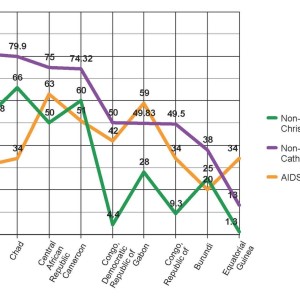

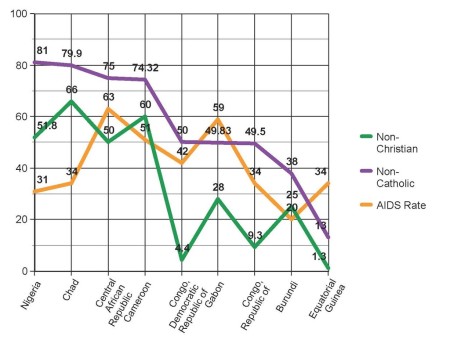
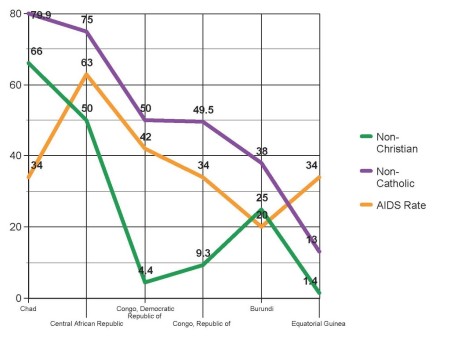
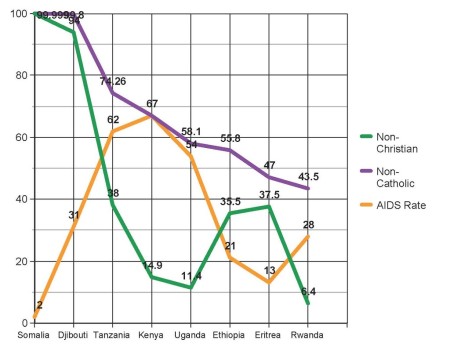
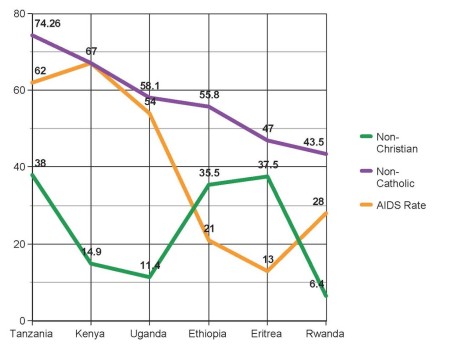
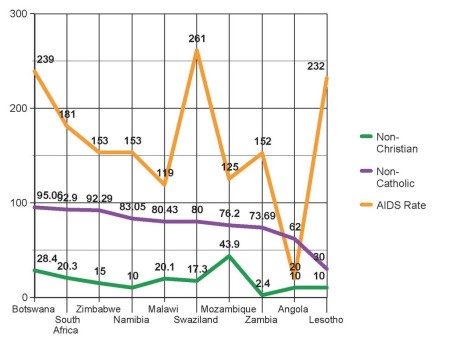

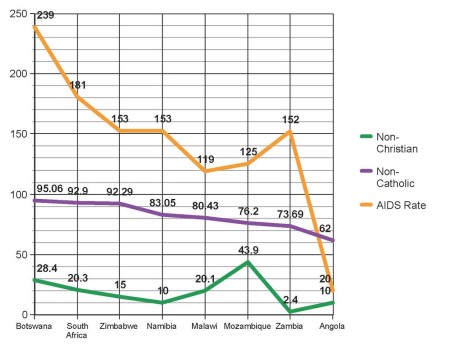
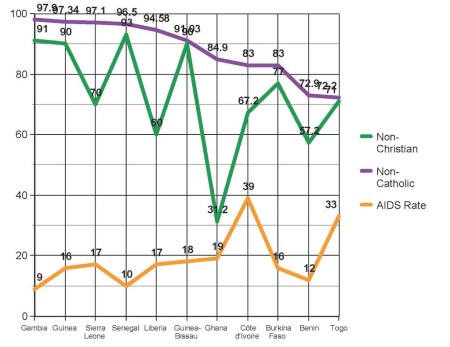
The thing which has always made me scratch my head with this issue is that, even *if* it could be demonstrated that there was a causal link between Catholic membership and the spread of Aids, what would it even prove?
If tomorrow everyone became Catholic and embraced the Church’s teachings on sexual morality, the Aids epidemic would have its legs taken out from under it. The only way this wouldn’t happen is if people obeyed *some* aspects of the Church’s teaching and *ignored* others.
I’ve often heard it expressed like this: people will always sleep around. If you ban them from using condoms it’ll just cause the spread of Aids.
It reminds me of a scene in Patriot Games where a guy, just before he’s about to go to bed with a woman who isn’t his wife, says to her that he won’t wear a condom because the Church says it’s a sin! What kind of tortured logic is that?!!
How can the Catholic Church be held responsible for people picking and choosing which parts of her teaching they’ll follow?!
Judge a medicine by those who actually take it.
RP,
Agreed. I actually wrote a paragraph talking about that issue, but I cut it, due to the length of this post. It’s almost as if the Church’s critics think Her stance is, “sleep with whomever you will, just make sure you don’t wear a condom.” Worse, this approach treats people (and especially Africans) as if they’re simply animals in heat who can’t fight their bodily urges.
The simple truth is, contra Toynbee, Dawkins, et al, Catholic teaching makes a huge difference for the better. Last year, when The Guardian was still publishing the lie that the pope said that condoms were okay “in certain cases,” one of their reporters actually bothered to interview African Catholics, and found that they were more against condoms than the pope (or at least, the Guardian’s imaginary version of the pope). So, for example, one of the men interviewed, Djoscky Bindusa Mongenda Tapo, said:
“As a Christian, as a spiritual fact, we cannot accept the use of condoms because to us marriage is between one man and one woman. The church has forbidden the use of condoms even if you are officially married because, if it allowed them, it also allows people to go around with prostitutes. Scientifically, the condoms are helping to protect people from the spread of many sicknesses and prevent premature pregnancies. Sex without condoms is a risk to people’s health and their families.”
He concluded: “Both sides are good but, as Christians, we are not afraid of sickness or to die, but we are afraid of the law of God. As God said one man is for one woman, we cannot go against God for other reasons. But if you are not Christian, you can use condoms if you have partners outside marriage.”
Tapo’s point is the same as Green’s: when the use of condoms is normalized, the number of sexual encounters and number of sexual partners go up, particularly among risky sex (like sex with prostitutes and those known to have AIDS). Like you said, the flip side is true, as well: follow Catholic teachings, and the odds that you get AIDS is dramatically lower than those around you.
God bless,
Joe.
i have always felt the same way, atheists like dawkins always talk about “hard facts ,and sound reason” but it never amazes me how fast they throw facts out the window when they dont fit the agenda or by doing so gives them an opportunity to smear the catholic church,take homosexuality as far as christopher hitchins and company are concerned it is a perfectly healthy lifestyle,of course to do this they have to ignore the mountain of medical facts that cases of hiv,aids,anal cancer,alcoholism,depression,suicide,drug abuse ect.is so very high,but of course the truth must be buried because they know the mass media treat homosexuality as the sacred cow that must never be spoken against and always at all times be show in a positive light,they know the only thing stating facts like these will get you is shunned by the mass media,and that would not do at all because where then would they get their air time to rant their anti catholic ravings and advertise their hate filled books,what a bunch of con men
Wouldn’t allowing gay marriage PREVENT most of those problems? Gays aren’t allowed to have gay marriage so is it really a surprise they would spend there lives being with multiple partners? They’re depressed suicidal drug abusers because they’ve been banned from experiencing what is considered to be one of the happiest and most romantic forms of a relationship all because a bunch of morons with “Adam and Eve not Adam and Steve” rhetoric don’t want it. All o those problems are a result of the ban on same sex marriages not a result of homosexuality.
I’m sorry but whether you’ll admit it or not the catholic churches abstinence teachings aren’t helping and most people in those countries don’t even know how to use condoms or have access to them so you can’t say they all chose not to use condoms. Providing education and access to condoms can and will help at least slow the spread of the epidemic which is better than what abstinence has ever done.
No one has really argued abstinence helps spread AIDs we’ve only argued it’s ineffective at preventing the spread of AID’s. You wasted resources on obviously failed teachings and instead of embracing a better solution to save lives the catholic church condemns it in the name of morality and tradition which is ironically immoral. The catholic churches inability to prevent the spread does make them responsible for the deaths because they made it their duty to prevent the spread and accepted millions of donations for that effort from all around the world and they waste it when they could use it to save lives. You do cause those deaths because you take that money that was supposed to be used to save lives and waste it on teachings you know solve nothing all in the name of your god you but of sick bastards.
just something i used to think about,in a society that seems so obsessed with advertising standards and the powers that be always seem ready to pounce when they feel false advertising is being used how do condom companies get away with saying that by using condoms is “safe sex”, i mean we all know that condoms are not 100 percent safe if so should they not be advertised as “safer sex” why dont condom boxes carry warnings on the front like cigarette boxes telling people that using condoms are not guaranteed to prevent disease and unwanted pregnancies after all arent sti,s and std,and unwanted pregnancies at epedemic levels.i often wondered if tobacco companies came up with a cigarette that had 96% less nicotine and started advertising it as “a safe cigarette” and that if all people would only smoke these safe cigarettes all tobacco related illnesses would simply vanish!i wonder just how long they the tobacco companies would get away with it.
So I think you don’t need all these plots to argue AIDS rates and Catholicism. I don’t think that’s really Toynbee’s point. Toynbee probably wishes Catholic charities would provide condoms and sex education to Africans, and thinks that, because they do not do this, those extra deaths that resulted from not using condoms are the Catholic Church’s responsibility.
This strikes me as irrational anti-Catholicism. Catholics are doing a service with their charities, a service atheists and agnostics like myself do not even come close to in any way. It would not be surprising that AIDS is lower in Catholic countries because care and charity are higher in these same countries.
I think that the Catholic refusal to use or give out condoms is rediculous; it’s a silly little rule. But it’s Catholics’ silly little rule, and since they are the ones doing all this hard work, if they choose not do hand out condoms, that’s fine.
If it’s such a big deal to Toynbee, she should stop complaining in the news, and organize condom distribution in Africa. Or she could support WorldVision (and many other groups) that already provide sex education and condoms.
—
That said, your analysis is terrible. You provide no statistical model whatsoever, you don’t explicitely include errors in your analysis, and you do not even provide for other causal factors. For example, I mentioned WorldVision above. Maybe it’s easier for them to get into countries with higher Catholic population, and so contraception they provide is more available in Catholic dominated areas than in non-Catholic areas. Also, it may be that the non-Catholic Africans are against contraception, though for different reasons, and so the correlation has nothing to do with condom use.
Bottom line, I suspect that careful analysis will show that condoms in Africa save many lives. Catholics won’t distribute the condoms and they shouldn’t have to. We who think condoms should be distributed should stand up and put our money and our time where our mouths are. We should start working and stop complaining.
We especially shouldn’t be whining at the group in Africa that, out of all the organizations and charities currently active, probably does the most amount of good.
I think this analysis is terrible for other reasons… The criticism in the Guardian article is of Catholic charities who refuse to include condoms or education about safer sex methods in their work. These groups and their work have nothing to do with the percentage of Catholics living in the country or whether the country is already Catholic-er than surrounding countries. An analysis that would answer the Guardian’s accusation would be one comparing the relative political leverage of family planning initiatives and service provisions of Catholic charities in each country under scrutiny.
Considering that most Catholics also ignore the no birth control / natural family “planning” mandate of the church anyway, I’d imagine that even this analysis as it is tells us nothing.
Dear Paul,
I appreciate you lamenting irrational anti-Catholicism. Yet, you criticize Joe’s data analysis (calling it terrible) and then say, “I suspect a careful analysis will show..”
Huh? Were you looking for a peer reviewed journal article on his blog? Moreover, how does one “suspect” data will say “x”? Isn’t science about just saying what the data says? Here is some peer reviewed research that shows that condom distribution has never worked at statistically significant levels. You could also turn to this article by Edward Green at the Harvard School of Public Health who sides with the Pope. Go figure.
Research in The British Medical Journal and the Linacre Quarterly, Daniel Halperin of Harvard and USAID researchers, et. al agree(s) with the major premise of Joe’s argument. Condom distribution and condom use does not curb AIDS, but rather–from the research–actually has an effect of promoting multiple partners because it diminishes the perceived effects of such behavior. That is what the data says. So, if we want to fight AIDS–which we both do–let’s work on strategies that data says work and not continue to push forward ideas that we have a suspicion will work–grounded in some judgment that any ideas to the contrary are based on some “silly rule”: cute but ineffective.
I think Paul Grimmer’s comments is illogical and quite misleading. Paul assume that condoms used is 100 percent safe which is a fallacy.
Many leading health experts have warned against depending on condoms for protection against AIDS and other STDs. Here’s a sampling of their comments:
“You just can’t tell people it’s all right to do whatever you want as long as you wear a condom. It (AIDS) is just too dangerous a disease to say that.”
Quote from: ¾ Dr. Harold Jaffee, chief of epidemiology, National Centers for Disease Control
“Simply put, condoms fail. And condoms fail at a rate unacceptable for me as a physician to endorse them as a strategy to be promoted as meaningful AIDS protection.”
Quote from: ¾ Dr. Robert Renfield, chief of retro-viral research, Walter Reed Army Institute
“Relying on condoms for ‘protection’ can mean lifelong disease, suffering, and even death for you or for someone you love.”
Quote from: ¾ Dr. Andre Lafrance, Canadian physician and researcher
“Saying that the use of condoms is ‘safe sex’ is in fact playing Russian roulette. A lot of people will die in this dangerous game.”
Quote from: ¾ Dr. Teresa Crenshaw, member of the U.S. Presidential AIDS Commission and past president of the American Association of Sex Educators.
What proof do we have that condoms used would have saved more lives than abstinent and having sex with only one partner ? Also, there is a huge problem with rapes in Africa (and in particular in Democratic Republic of the Congo and South Africa), do you think that rapists would use condoms ?
Cool blog, man!
I recently did a post similar to this on my blog too. But compared to this mine just seems insufficient and short.
Good job!
Paul,
I liked your comment quite a bit. The first half is a great insight, and I’m thankful that there are non-Catholics who see it.
As for the second half, suffice it to say that we don’t see an explosion of AIDS transmissions in the countries paying most attention to Catholic sexual ethics. It’s true, as you said, that alternate causalities may be in play. But that’s always true. And the burden should be on those claiming that the condom is effective at reducing AIDS to show where it’s done that anywhere in Africa.
The data compiled in this post, while admittedly basic, paints a clear picture: condoms are, at best, a failure; and at worst, are actually aggravating the situation.
You “suggest” that condoms are effective, but that’s obviously not evidence. Given the obsession much of the Left has with condoms as a solution, shouldn’t we be able to find some solid evidence suggesting that condoms are solving the problem in Africa? OR at least in some particular region in Africa? Where’s the empirical data supporting your “suspicion”?
Christian,
There’s a good chance I actually found that Toynbee quote while reading your blog. So you probably have yourself to thank that the post exists.
In Christ,
Joe
Joe,
Thank you for your kind words concerning Part 1. They are much appreciated.
Concerning Part 2, I think the big thing is that the spread of AIDS is a serious problem in all of Africa, especially in the southern part of the nation.
I suspect that increased proper condom use in any region will reduce the spread of AIDS in that region. This is based on the simple application of the effectiveness of the condom, properly used, for reducing the spread of AIDS for each sexual encounter, and accounts for the idea that condom use may encourage a greater amount of promiscuous sex. To the guy who called me “Grimmer”, whatever his name was, this doesn’t assume that condom use is 100% effective. Nowhere in my original post did I even suggest the percentage of success with condom use.
Now, about what Brent and you both ask about the data. Brent asks an excellent question: isn’t science just about what the data says? No. That’s because you can make the data say anything you like. Statistical science, in this case, is very similar to statistics applied to astrochemistry. You look at the data, you consider the error associated with the data, you try to find trends that reach outside the error bars, and then you try to model the trends. You don’t just say “Oh, well, I think that this trend means that condoms are wonderful/bad/etc.” You actually build a model to find out, and you make sure the model is properly coupled correctly with the data. Then you find out what new things the model predicts, and you go out and find if those new things work the way the model says. If the predictions work, then the theory underpinning the model is verified (for now). If not, it’s falsified and if there’s no good reason to keep it around, it should be abandoned for a new idea (or at least should be seriously augmented).
So let’s lead through the data and analysis step-by-step. The question is: how does condom use affect the rate of AIDS?
Step 1: Collect and understand the data. What are the units? What is being measured? Currently, you show concentration of Catholic belief and relate it to AIDS rates, which doesn’t directly connect to condom use. So this isn’t the ideal data. The data our question would best be answered with would involve three things: the actual amount of condom use, the amount of sex education, and the rate of the spread of AIDS. Percentage of Catholics may anti-correlate with condom use, or it may not. That’s a different question, one that would also be interesting to explore.
Step 2: Compare the data. Compare condom use to AIDS rate, and education to AIDS rate, and condom use to education. At this point, include errors. Do not at this or any other point remove data points. You can remove them from plots for cosmetic reasons (if the trend is more aptly shown without the points), but they absolutely must be included in the initial analysis. At this stage, do we notice any strong trends? Or do we have a pre-existing theory, for whatever reason (religious, maybe) about condom use and AIDS? Either way, its fine, and we can work with ideas no matter how we get them. Any idea is on equal footing at this stage.
Step 3: Construct a model based on your idea. Mathematically represent your idea as a mathematical theory, and apply that theory to try to reproduce the data you’ve collected and studied in Steps 1 and 2. In my case, I consider that condoms do two things: they reduce the chance that someone will get HIV from an individual sex act, and its success rate in this will be based both on the condition of the condom and on the proper use of the condom. Currently, I ignore the condition of the condom and focus only on sex education: I approximate the effectiveness of the condom as a function of the education someone has with the condom, to a maximum of 80% rate-effectiveness/year. Then I consider how much condom use encourages promiscuous sex (something ideally sex education would reduce, but I ignore this possibility as well, at the stage I’m at). It turns out that, for well-educated people using condoms, they would have to have promiscuous sex with AIDS infected partners at a rate of 6 to 8 times more with condoms than without, in order to negate the effectiveness of condoms entirely; more to overcome its effectiveness. Even at this point, my mechanism is not justified. What I do now is use a stochastic method to apply this theory about condom use to try to reproduce the data.
Step 4: Does the model reproduce the data? How well does it match, especially compared to other models? No removing points at this stage either, but now we can consider outliers, like your two points at the edge of that one plot. Why do they look like they do (imagine they still existed when considering more relevant data)? You speculated that it’s because the two nations are strongly Muslim, and so have strict sexual practices. Maybe this is so, but we can’t just get rid of the points on the base of you saying this is why. Instead, we go back to Step 3, and add a parameter to our model that approximates the effects of Islam. Then we come back to Step 4 and find out what effect this had on the data. Does it explain the outliers? How does it affect the rest of the data?
Step 5: Have we fit the model? Probably not very well. Reality is complex, and the situation of AIDS in Africa is exceptionally so. But we may have done better with our model than with any alternative. At this point, we consider what predictions this model makes abut regions where measurements have not been taken, or about new policies that would (according to our model) drastically affect results. We then take the new statistics, or implement the changes, and find out what happens. If it’s as we predict, then it’s most reasonable to accept the new model. If not, and if there’s no good reason to keep the model around, we throw it out and try another model (or we drastically change the original model).
Until Steps 1-5 are performed (something I’m partly working on with a friend of mine in the mathematics department, for a refereed publication), there is no way to say definitively what condom use does to affect the spread of AIDS. You say that your data paints a clear picture. It does, because of the way you’ve handled it. If you gave it to a liberal who had a very strong agenda of getting condoms to Africa and who used the same sort of statistical “method” you have, his results would paint a clear picture as well, that condom use is a great success! Data, handled carelessly, will make whatever picture you like. If you want an objective answer, then an objective method of handling data, like the one above, needs to be implemented.
It will be interesting to see what theory happens to be best supported, once the analysis is complete.
Paul,
I’d love to see your resulting data (and conclusions) if and when you do put this all together. I’d also like to see more specifically on the relationship between condom distribution and promiscuous (particularly high-risk) sex. How do you account for the position taken by non-religious (as far as I know) folks like Dr. Green saying that condoms are making the situation worse? Surely, he’s not unfamiliar with the empirical evidence, right?
God bless,
Joe
Joe,
Ideally, when considering the data and cause-and-effect, religion should make no difference. Dr Green’s work, as far as I am familiar with it, seems solid. He can’t make sweeping statements about the effectiveness of condoms, and doesn’t try.
He talks about his personal experience and others experiences in different regions, and proposes, based on this experience and also on a cursory consideration of the data, that condoms may not always be the effective solution. I tend to suspect that he’s correct. The best solution will likely be a combination of condom use, sex education, abstinence education, and a transformation of the African culture, for example the rape sub-culture that has come about in militant groups in Africa (similar to that in Bosnia). There are cultural reasons that condom use in certain regions is rejected as well, and it may be that culture cannot be changed immediately, so other methods will have to be implemented, like abstinence (something that should be a key component in any AIDS prevention work).
Dr Green also holds that condom use is a good thing, in certain places in Africa and in Thailand, especially. He seems to think it should be a part of most AIDS prevention work, and that it should be central (and is highly effective) in AIDS prevention work in regions where high-risk sexual practices are already prevalent (such as in Thailand brothels).
Since currently, to my knowledge, no comprehensive stochastic model has been applied to try to explain the data or make new predictions, there is no way right now to say who is correct.
I will send you a draft paper when we have gotten to that point. It may be a while (likely not until January or February), because I am still working on finishing my dissertation.
Thank you for an excellent post. God reward you.
Great post
Here is an article by the “conservative” and “Catholics friendly” NY Times about how Contraceptive Used in Africa May Double Risk of H.I.V.
http://www.nytimes.com/2011/10/04/health/04hiv.html?_r=2&partner=rss&emc=rss&src=igw
The findings are also backed by two previous, but more limited, studies. So much for the atheist who have done nothing for the Africans yet they continues to attacks the Catholics Church teachings and Catholics charities in Africa.
It must be difficult for atheists to admit that the Catholics Church is right about these matters: abstinence or faithfulness in marriage tend not to carry a death sentence…Living those values, well, that’s a different story but the difficulty entailed does not make the theology wrong.
It seems to me that the evidence (even if not statistically appropriately analysed) suggests that:
– the pope/cath. church can NOT be blamed to be the major cause of the world wide HIV epidemic.
And there seem to be two adverse points of view:
1. the CONDOMS ONLY PROTECT AND THEREFORE ENJOY LIFE (SEX) opinion which very likely is not true because condoms do fail and because this philosophy probably encourages to be more promiscous in general
2. the catholic BE STRICTLY ABSTINENT BEFORE MARRIAGE AND BE FAITHFUL IN MARRIAGE AND DO NOT USE CONDOMS opinion which is true but at the same time is idealistic because man is in danger to commit sin all the time what is dangerous especially in countries with high infection rates.
CONCLUSION:
I suspect that it would be possibly wise if the catholic church sticks to its sex morals and at the same time does not condemn the use of condoms in case that people just are in a personal situation where they are in risk of breaking catholic rules for whatever reason (and this happens in humans non-ideal lifes and even catholic lifes!).
So the pope might say:
1. Priority is: stay abstinent or be married loyally.
2. if you fail rule no. 1 then you commit a sin according to catholic thinking but for not making your sin even worse by possibly getting infected and/or spreading a disease, AT LEAST use condoms for reducing the risk of infection.
This is my proposal even though I do not know whether it would work either.
HI My Name is MARIAN DUSS, I wish to share my testimonies with the general public about what this man called Dr LAWCY of( [email protected] ] has just done for me , this man has just did what I thought nobody will ever do for me, i was HIV positive when one of my family friend introduce this man to me, I never believed that great DR LAWCY could do this, when I contacted him on this same issue on ground, he casted some spell for me and gave me some parcel to drink, now I am so happy to say that the virus I was having In my body have left me. All thanks to DR LAWCY. If you are out there passing through this same kind of problems you can contact him today on his mail ( [email protected] ) and he will also help you as well with his great spell caster, THANKS BE TO DR LAWCY….
Out of curiosity, I went over the CIA factbook and checked the correlation between the percentage of Catholics in different African countries and the percentage of AIDS victims. I didn’t use countries where the fraction of Catholics is not specified.
Rwanda 56 5.1
Congo 50 4.2
Gabon 50 8.1
Angola 47 3.9
Uganda 42 4.1
Kenya 33 6.7
Kamerun 25.7 6.9
Mozambik 23.8 12.2
Zambia 20 16.5
Malawi 19.6 14.2
Namibia 16 21.3
Zimbabwe 7.7 24.6
RPA 7.1 21.5
Botswana 5 37
r= -0.86; P<0.0001
This correlation is based on a decade-old data. It weakens for a newer data (probably due improvement of the treatment and prevention). Still, it remains negative.
Buy condom online in India, which will be safer to use and also medically approved and branded condoms. Condoms store in online was served by condomking.in with satisfied quality.
Using condom is a more secure way of having sexual relationship with others. Thanks for your kind share. online condom store in india
Dawkins is the sort of guy who’ll just throw out any objection that might kinda sorta seem plausible at face value to discredit the church; the sort of guy who spends his life complaining about every single aspect of religions he doesn’t like.